| Pages:
1
..
6
7
8
9
10
..
12 |
simply RED
Hazard to Others
  
Posts: 209
Registered: 18-8-2005
Location: noitacoL
Member Is Offline
Mood: booM
|
|
I have bought a "100% nitric acid" that was stored for tens of years in the "store". It was so impure that no RDX could be synthesized with it no
matter with hexamine or HDN. Even after purging yield was low. But it was very good for nitrate esters...
When logic and proportion have fallen sloppy dead...
|
|
|
Napolean Dynamite
Harmless

Posts: 15
Registered: 6-4-2014
Member Is Offline
Mood: sweet
|
|
I have a relative who does some blasting operations in mines and uses RDX left over from WW2 on occasion.
|
|
|
Ral123
National Hazard
   
Posts: 735
Registered: 31-12-2011
Member Is Offline
Mood: No Mood
|
|
Quote: Originally posted by simply RED  | | I have bought a "100% nitric acid" that was stored for tens of years in the "store". It was so impure that no RDX could be synthesized with it no
matter with hexamine or HDN. Even after purging yield was low. But it was very good for nitrate esters... |
I've noticed quite nice yields from crude distilled NA/hexamine. Was your NA slightly yellow or dark red? I wonder if bubbling O2 or adding urea
peroxide is a partial solution?
As for storing crystalline RDX, in my opinion it burns no slower then smokeless powder, and is no less flammable. Could it be that DDT in case of
accident is a significant hazard. I've noticed the industry and military is staying away from crystalline material unless for basecharge/booster
charges maybe.
|
|
|
simply RED
Hazard to Others
  
Posts: 209
Registered: 18-8-2005
Location: noitacoL
Member Is Offline
Mood: booM
|
|
The NA was dark red with no chance to be completely purged. Yes, fresh distilled always gives good yields.
When logic and proportion have fallen sloppy dead...
|
|
|
Manifest
Script Kiddie Asshole
  
Posts: 229
Registered: 7-12-2012
Member Is Offline
Mood: No Mood
|
|
Where the hell do you get Acetic Anhydride in the UK? Is it used in heroin production? Is that why it's so hard to come by?
|
|
|
VladimirLem
Hazard to Others
  
Posts: 204
Registered: 24-5-2010
Member Is Offline
Mood: Have no fear <Vlad> is here.
|
|
Quote: Originally posted by Manifest  | | Where the hell do you get Acetic Anhydride in the UK? Is it used in heroin production? Is that why it's so hard to come by? |
yepp...its pretty hard to get it these days cause you can make diacetylmorphine with it....and many many interesting explosives too IF you had it...
|
|
|
Ral123
National Hazard
   
Posts: 735
Registered: 31-12-2011
Member Is Offline
Mood: No Mood
|
|
I have a little of such acid http://en.wikipedia.org/wiki/File:Fuming_nitric_acid_40ml.jp...
I tried a little CO(NH2)2 and H2O2 30% and bubbling O2, but they didn't change it much. Both gave vigorous reaction. Do you think I have a chance if I
heat it to 30-40C and try to suck the NOx with a 50ml syringe? May be a straw starting with azide, then ETN and finally RDX can show their performance
in small diameters.
|
|
|
simply RED
Hazard to Others
  
Posts: 209
Registered: 18-8-2005
Location: noitacoL
Member Is Offline
Mood: booM
|
|
I could not succeed purging very degraded acid. The answer is to use it fast after distilation.
When logic and proportion have fallen sloppy dead...
|
|
|
Ral123
National Hazard
   
Posts: 735
Registered: 31-12-2011
Member Is Offline
Mood: No Mood
|
|
I've had a super quick runaway when heating to 50C. It destroyed all the yield. The batch was only 30ml, I suspect there may have been unreacted
material. My 300ml runaway took a lot of seconds after 30C to take off. In my second attempt(again 30ml WFNA/straight hexamine) I had about the volume
of a well rounded tea spoon of fluffy material.
|
|
|
markx
National Hazard
   
Posts: 646
Registered: 7-8-2003
Location: Northern kingdom
Member Is Offline
Mood: Very Jolly
|
|
I wonder...has anyone here succeeded in the E-method synthesis of RDX? I have found a couple of references on the net and also on this board, but it
all seems very inconclusive. Mostly a failure is reported and the conditions are not very well described. The original patent text is also quite vague
and of not much use if one tries to retrace the steps of original synthesis. I'm very facinated by this route of synthesis as it is (if it supposedly
works..of which I am not so sure at all) the only method that does not require the presence of WFNA. Even if the yields would be low compared to other
methods, I would still welcome the possibility to get by without WFNA....it's just a pain to distill. I have done it, but really the benefits do not
outweigh the hassle. I find it is wasteful in amateur setups and there is no point in going pro on utilisation of the wastes....exponential growth in
trouble 
As a matter of fact I did perform a quick proof of concept experiment on the E method myself last year (small scale of course)....but I was sloppy and
careless in preparation, lacking the proper equipment. Temperature was fluctuating...It was a total failure, but I have not given up yet.
The questions that plaque me are:
Is the presence of the catalyst of undeniable importance in initiating the reaction?
What is the correct temperature for performing the E method syntesis without the catalyst?
What kind of degree of polymerization is optimal for the paraform to be used ? There are different varieties out there and they do have different
properties.
But as far as I have understood these questions have been asked before by so many....
Nevertheless, I would really appreciate it if anyone cares to share their knowledge or/and experiences on the subject.
Exact science is a figment of imagination.......
|
|
|
caterpillar
Hazard to Others
  
Posts: 472
Registered: 8-1-2012
Member Is Offline
Mood: No Mood
|
|
Well, let's try to compare usual method (or K- method) with E-method. If you have not Ac2O in a hand reach, its preparation is a headache too. I
suspect, that it is more problematic, than distillation of nitric acid. I know about some methods like distillation of dry mix- CH3COONa + Al2(SO4)3.
But it is distillation too and requires higher temperature. And what about catalyst- BF3? Where do you plan to get it? But distillation of nitric acid
is not as difficult, as you think. Steel does not react with concentrated HNO3 and you may use coffee pot instead of glass distillation apparatus. Use
asbestos instead of gum corks. Nothing extra ordinal.
Women are more perilous sometimes, than any hi explosive.
|
|
|
Motherload
Hazard to Others
  
Posts: 245
Registered: 12-8-2012
Location: Sewer
Member Is Offline
Mood: Shitty
|
|
I have access to AcAn. I have about 3 liters at the moment.
I however don't have any paraformaldehyde but lots of trioxane.
The only reason I haven't attempted the synth is because I live in a
densly populated area and don't know what kind of attention gathering
odors this method might produce aswell as if the trioxane can be substituted
for para.
Any input ?
"Chance favours the prepared mind"
"Fuck It !! We'll do it live !!"
|
|
|
markx
National Hazard
   
Posts: 646
Registered: 7-8-2003
Location: Northern kingdom
Member Is Offline
Mood: Very Jolly
|
|
What isomer of trioxane are you in posession of? I trust the 1,3,5-trioxane might be a good candidate for its symmetry, but I have no evidence to back
it up. It seems the E method is one of the least favored routes....I have not seen many references to it, apart from rather shallow descriptions in
Urbanski and the original patent texts. Some older posts from forums and descriptions of attempts to apply the method circle the net, but their
credibility is to be taken with a grain of salt. I guess in light of that fact there has to be a reason for it.
Actually the biggest problem that I saw when attempting the synthesis last year was the fact that neither paraformaldehyde nor ammonium nitrate were
soluble in hot Ac2O to any noticeable degree. It might be a slow process that takes more time or requires a higher temperature or a different paraform
with lesser polymerisation, but my heating failed and I could not keep the temp above 60C for more than 20min. But alas, during that time I saw no
appreciable dissolving of the components.
Exact science is a figment of imagination.......
|
|
|
Motherload
Hazard to Others
  
Posts: 245
Registered: 12-8-2012
Location: Sewer
Member Is Offline
Mood: Shitty
|
|
I have 1,3,5 trioxane used in military fuel tablets, which I purified by subliming it.
Megalomania's method required the temp to be around the 90*C mark if no catalyst is used. On the other hand ... I am tempted to use it with HNO3 and
NH4NO3 and Hexamine for better yields, once I get around to distilling some HNO3..
Trying to figure out which method is more efficient and economical.
AcAn costs me about $55 a litre and can only buy a litre every couple of months without raising suspicion.
"Chance favours the prepared mind"
"Fuck It !! We'll do it live !!"
|
|
|
caterpillar
Hazard to Others
  
Posts: 472
Registered: 8-1-2012
Member Is Offline
Mood: No Mood
|
|
Perhaps, there is a better way to use Ac2O. You may try to prepare Solex or HMX. Read corresponding articles from dear Jared.
Women are more perilous sometimes, than any hi explosive.
|
|
|
Motherload
Hazard to Others
  
Posts: 245
Registered: 12-8-2012
Location: Sewer
Member Is Offline
Mood: Shitty
|
|
Not as efficient use according to the patents. Besides I will generate some HMX in the E Method.
HMX synth requires a large surplus of WFNA and AcAn. Doesn't seem feesable .... Econo wise given the marginal better performance.
[Edited on 8-5-2014 by Motherload]
"Chance favours the prepared mind"
"Fuck It !! We'll do it live !!"
|
|
|
markx
National Hazard
   
Posts: 646
Registered: 7-8-2003
Location: Northern kingdom
Member Is Offline
Mood: Very Jolly
|
|
Right....I pulled myself together and gave the E method a new try. I built a PID thermostating system and rigged up a water bath with it. Into the
bath I placed a tall retort equipped with a thermometer and magnetic stirrer.
I measured 27ml of acetic anhydride into the retort, turned on the mixing and let it equilibriate at 90C. This took some overhead from the PID
setpoint...about 2,7C to be exact (the PID setpoint @ 92,7C).
As the anhydride was heating up I weighed 10g of ammonium nitrate into one beaker and 3,6g paraform into another.
I added about 1/3 of the AN to the hot acetic anhydride and watched it crumble and dissolve partially...OK, good sign 
I then proceeded to addin the paraform in small amounts...perhaps 40mg at a time. Immediately the temperature in the retort rose to 92C and a
noticeable gas emission began in the liquid. Sucess!! I have a definite reaction! I proceeded with adding the paraform and AN in small increments,
watching the temperature and keeping it in the limits of 88-92C. To accomplish that I added ice cubes to force the temperature down when it rose above
92C, the PID took over to bring it back up to 90C. As temperature fell below 88C the bubbling almost stopped and reaction seemed to grind to a halt.
The whole process took 75minutes, accompanied by vigorous bubbling of the anhydride, some brownish gas emission as temp went above 92C and the gradual
vanishing of solid precipitate of AN and paraform from the retort.
After having completed the addition of the components I kept the temperature at 90C and the stirring on. Bubbling stopped about 10-15min after having
added the last of paraform and no solid preciptate is seen in the retort....the Ac2O is slightly milky though. Liquid seems to have a greenish tint.
I turned off the heating and lifted the retort out of the water bath to let it cool down.
After about 10min it had cooled to around 60C and I crashed the contents into 500ml of ice cool water. Water turned opaque, but no immediate
precipitate like when crashing the WFNA and RDX mixture from the straight nitrolysis.
After letting the whole cocktail sit for another 15 min I see a slow precipitaton of fluffy white solid....seems awful lean. Maybe a few mm thick
layer on the bottom of the beaker. I'll just let it seddle for 24h and then proceed with filtering and further tests. At least a reaction and a
result...yet inconclusive though 
Exact science is a figment of imagination.......
|
|
|
Turner
Hazard to Others
  
Posts: 197
Registered: 2-12-2013
Member Is Offline
Mood: No Mood
|
|
You should post the yield when it dries
|
|
|
markx
National Hazard
   
Posts: 646
Registered: 7-8-2003
Location: Northern kingdom
Member Is Offline
Mood: Very Jolly
|
|
The yield will unfortunately be absolutely dismal.....I can already tell by the eye. I will report the numbers tomorrow when it has dried.
Although I can confirm that the precipitate is RDX (at least the majority of it). I forced a small amount to dry at elevated temperature and did the
burn test....characteristic hiss and flame. I compared it to the confirmed sample product from straight hexamine nitrolysis from last year...
As for the catalyst...perhaps one could use a less volatile analogue of BF3? Perhaps ZnCl2, AlCl3, TiCl4, SnCl4 could have a similar beneficial
effect? Any comments and suggestions are welcome and valued.
I really would like to explore this synthesis route in more detail and practice...for some reason I find the E-method especially appealing.
[Edited on 15-5-2014 by markx]
Exact science is a figment of imagination.......
|
|
|
markx
National Hazard
   
Posts: 646
Registered: 7-8-2003
Location: Northern kingdom
Member Is Offline
Mood: Very Jolly
|
|
The numbers are in........dried yield without recristallisation was 0,7g.
This amounts to about 12% of the expected yield when calculated based on the numbers of Urbanski (which is already represented as a 65% yield compared
to theoretical maximum).
Absolutely dismal, as I already stated....but now the concept is proven. It is possible to form RDX without the direct involvement of concentrated
nitric acid. Time to begin with the development and introduction of improvements!
First of all I think that recristallisation of AN should be a starting point, as I used a fertilizer grade and it is not the purest one around.
Secondly the investigation of different synthesis temperatures could yield some insight on possible improvements in yield.
And as a third option the investigation of possible alternative catalysts from the lewis acid family.
As it happens I still have the connections to my former employers who engage in the field of carbide derived carbon synthesis. Chlorination of metal
carbides at high temperatures that yields a residual carbon skeleton with very special properties and a huge amount of chlorides (most of which are
strong lewis acids TiCl4, AlCl3, boron and molybdenum clorides too). So I should be in a sweet spot with regards to obtaining possible catalysts 
Found a reference to another descrition of the E-method. In this one the use of BCl3 is noted...could be a mispelling or a reference to the
possibility of using another catalyst.
Find the article attached:
[Edited on 16-5-2014 by markx]
Attachment: Conception for the investigation of contaminated munition plants.pdf (404kB)
This file has been downloaded 642 times
Exact science is a figment of imagination.......
|
|
|
markx
National Hazard
   
Posts: 646
Registered: 7-8-2003
Location: Northern kingdom
Member Is Offline
Mood: Very Jolly
|
|
I performed a second run of the E-method to get some illustrative material:
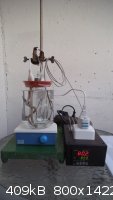 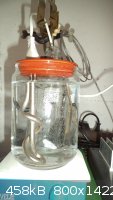 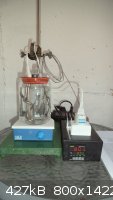
The improvised synthesis apparatus
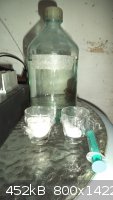
The reagents (27ml Ac2O, 3g paraform, 16g dried AN)
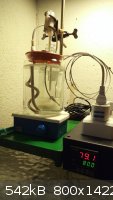 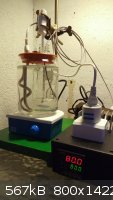
Equilibriating to 80C and addition of AN
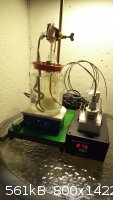 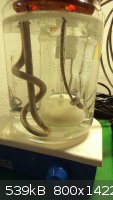 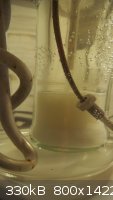 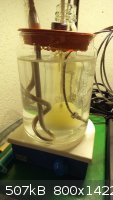
Equilibriating to 88C with small amount of paraform added. Start of reaction with the release of brown fume. Slow addition of paraform is continued.
Vigorous gas evolution is observed in the solution and the reactor temperature is kept within 89-90C by the exotherm.
[Edited on 21-5-2014 by markx]
[Edited on 21-5-2014 by markx]
Exact science is a figment of imagination.......
|
|
|
markx
National Hazard
   
Posts: 646
Registered: 7-8-2003
Location: Northern kingdom
Member Is Offline
Mood: Very Jolly
|
|
Continuation of the process:
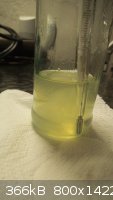 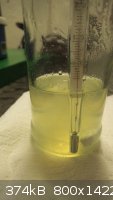 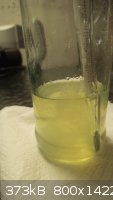
The reaction is finished with all of the AN and paraform consumed. The end of the reaction proceeded with extraordinary vigor by consuming about half
of the solid AN still left in the reaction within a few minutes. The exotherm was not excessive though...a rise of only 1,5C to a maximum of 90,5C and
then a sudden drop to 88C of the waterbath equilibrium.
Solution was left to cool and then crashed into 500ml cold water. The pictures show the resulting precipitate after about 7 hours .
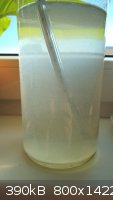 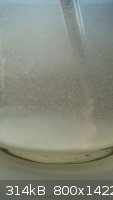
Again the yield is low and judging by the eye it matches the result from first synthesis.
I tried to perform the synthesis on a lower temperature this time (80C), but it will not start under 88C without any catalyst. I'm starting to think
that the lewis acid catalyst plays a key role in this synthesis and without it the yield will suffer greatly from the side reactions and or possibly
the too high temperature of the reagent mixture.
Exact science is a figment of imagination.......
|
|
|
Motherload
Hazard to Others
  
Posts: 245
Registered: 12-8-2012
Location: Sewer
Member Is Offline
Mood: Shitty
|
|
Your ratios seem off.
3 gm para and 16 gm NH4NO3 for 27 ml of AcAn.
Mega's method used around 10 gm para and around 12 gm NH4NO3 scaled down 10X iirc.
His page is down ... I'll look for a hard copy.
I have heard people on the board, disliking his methods, but can be used as a guide.
"Chance favours the prepared mind"
"Fuck It !! We'll do it live !!"
|
|
|
markx
National Hazard
   
Posts: 646
Registered: 7-8-2003
Location: Northern kingdom
Member Is Offline
Mood: Very Jolly
|
|
Quote: Originally posted by Motherload  | Your ratios seem off.
3 gm para and 16 gm NH4NO3 for 27 ml of AcAn.
Mega's method used around 10 gm para and around 12 gm NH4NO3 scaled down 10X iirc.
His page is down ... I'll look for a hard copy.
I have heard people on the board, disliking his methods, but can be used as a guide. |
In the first synthesis I used the ratio 3,6/10g para/AN based on an old post from parazite forum (could be total rubbish)....in the seconf one I used
the ratio given in the original Ross Schiessler patent and that was stated as 3/16g. Anyways the result was just about the same with both ratios.
Of course any suggestions on how to improve the situation are welcome 
Exact science is a figment of imagination.......
|
|
|
markx
National Hazard
   
Posts: 646
Registered: 7-8-2003
Location: Northern kingdom
Member Is Offline
Mood: Very Jolly
|
|
I just finished drying the yield from the second synthesis and as a matter of fact it was only 0,35g......so just about exactly 50% less than the
first result. The difference was in the ratios of parform/AN. It seems that the original patent ratio works much worse on my particular set of raws
than the 3,6/10g ratio that I used in the first synthesis. Some food for the thought...
Exact science is a figment of imagination.......
|
|
|
| Pages:
1
..
6
7
8
9
10
..
12 |